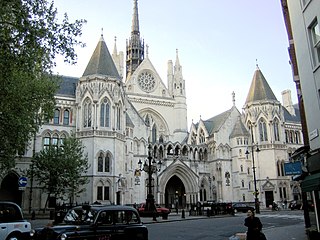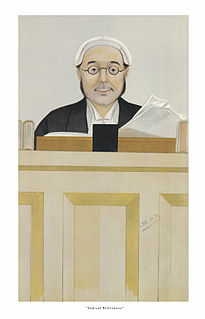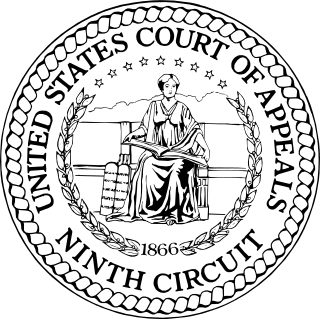Phillips v Homfray [1] is an important landmark decision in English law of restitution. [2]

English law is the common law legal system of England and Wales, comprising mainly criminal law and civil law, each branch having its own courts and procedures.
The English law of Restitution is the law of gain-based recovery. Its precise scope and underlying principles remain a matter of significant academic and judicial controversy. Broadly speaking, the law of restitution concerns actions in which one person claims an entitlement in respect of a gain acquired by another, rather than compensation for a loss.
The court case lasted 20 years, and was complicated by the death of one of the defendants. It involved a matter in which the defendant had committed a trespass to land of his neighbor by tunneling under the plaintiffs' land and mining coal from it.
Trespass to land is a common law tort or crime that is committed when an individual or the object of an individual intentionally enters the land of another without a lawful excuse. Trespass to land is actionable per se. Thus, the party whose land is entered upon may sue even if no actual harm is done. In some jurisdictions, this rule may also apply to entry upon public land having restricted access. A court may order payment of damages or an injunction to remedy the tort.
A plaintiff is the party who initiates a lawsuit before a court. By doing so, the plaintiff seeks a legal remedy; if this search is successful, the court will issue judgment in favor of the plaintiff and make the appropriate court order. "Plaintiff" is the term used in civil cases in most English-speaking jurisdictions, the notable exception being England and Wales, where a plaintiff has, since the introduction of the Civil Procedure Rules in 1999, been known as a "claimant", but that term also has other meanings. In criminal cases, the prosecutor brings the case against the defendant, but the key complaining party is often called the "complainant".
Joseph and John Phillips owned a farm of 116 acres, in Monmouthshire. Unbeknownst to them their neighbours, the Tredegar Iron Company, extracted 2000 tons of coal from under their farm [3] The plaintiff sought in equity an account of profits, and rent for the use of the subterranean portion of their property.

A farm is an area of land that is devoted primarily to agricultural processes with the primary objective of producing food and other crops; it is the basic facility in food production. The name is used for specialised units such as arable farms, vegetable farms, fruit farms, dairy, pig and poultry farms, and land used for the production of natural fibres, biofuel and other commodities. It includes ranches, feedlots, orchards, plantations and estates, smallholdings and hobby farms, and includes the farmhouse and agricultural buildings as well as the land. In modern times the term has been extended so as to include such industrial operations as wind farms and fish farms, both of which can operate on land or sea.

The acre is a unit of land area used in the imperial and US customary systems. It is traditionally defined as the area of one chain by one furlong, which is exactly equal to 10 square chains, 1⁄640 of a square mile, or 43,560 square feet, and approximately 4,047 m2, or about 40% of a hectare. Based upon the International yard and pound agreement of 1959, an acre may be declared as exactly 4,046.8564224 square metres. The acre is a statute measure in the United States and was formerly one in the United Kingdom and almost all countries of the former British Empire, although informal use continues.

Monmouthshire is a county in south-east Wales. The name derives from the historic county of Monmouthshire of which it covers the eastern 60%. The largest town is Abergavenny. Other towns and large villages are Caldicot, Chepstow, Monmouth, Magor and Usk. It borders Torfaen and Newport to the west; Herefordshire and Gloucestershire to the east; and Powys to the north.
The Court of Appeal eventually found for the plaintiff, and ordered an inquiry into the value of the coal that had been mined by the defendant. [4] This inquiry was delayed for some years. The Court ruled for restoration of the wrongfully appropriated profits. The court eventually concluded that the plaintiff could sue the deceased's estate, but only granted the first of the sought remedies.

A defendant is a person accused of committing a crime in criminal prosecution or a person against whom some type of civil relief is being sought in a civil case.
The decision became precedent in Australia with the decision in Waddell v Ross [5] and Finlay v Chrney [6] a decision given by Charles Bowen LJ who delivered the majority decision in Phillips v Homfray. [7]

Australia, officially the Commonwealth of Australia, is a sovereign country comprising the mainland of the Australian continent, the island of Tasmania and numerous smaller islands. It is the largest country in Oceania and the world's sixth-largest country by total area. The neighbouring countries are Papua New Guinea, Indonesia and East Timor to the north; the Solomon Islands and Vanuatu to the north-east; and New Zealand to the south-east. The population of 25 million is highly urbanised and heavily concentrated on the eastern seaboard. Australia's capital is Canberra, and its largest city is Sydney. The country's other major metropolitan areas are Melbourne, Brisbane, Perth and Adelaide.

Charles Synge Christopher Bowen, Baron Bowen, was an English judge.

A Lord Justice of Appeal or Lady Justice of Appeal is an ordinary judge of the Court of Appeal of England and Wales, the court that hears appeals from the High Court of Justice and the Crown Court, and represents the second highest level of judge in the courts of England and Wales. Despite the title, and unlike the former Lords of Appeal in Ordinary, they are not necessarily peers.
A second appeal was launched to secure an account of the profits from Fothergill's land. The defense rested on the rule Actio personalis moritur cum persona . Citing dicta from Hambly v. Trott [8] [9] the King's Bench court held that the only action that died with the defendant was actions where the defendant had caused a loss to the plaintiff. In this case the damages weren't for injury to the plaintiff but for the return of goods, and also because the defendant's estate had benefited from the extraction of the coal; the estate itself had become a beneficiary and so was liable for the return of the profits.
Actio personalis moritur cum persona is a Latin expression meaning "a personal right of action dies with the person".
Hambly v Trott is a landmark Court case in conversion and trover.

The Court of King's Bench, formally known as The Court of the King Before the King Himself, was an English court of common law in the English legal system. Created in the late 12th to early 13th century from the curia regis, initially following the monarch on his travels, the King's Bench finally joined the Court of Common Pleas and Exchequer of Pleas in Westminster Hall in 1318, making its last travels in 1421.

